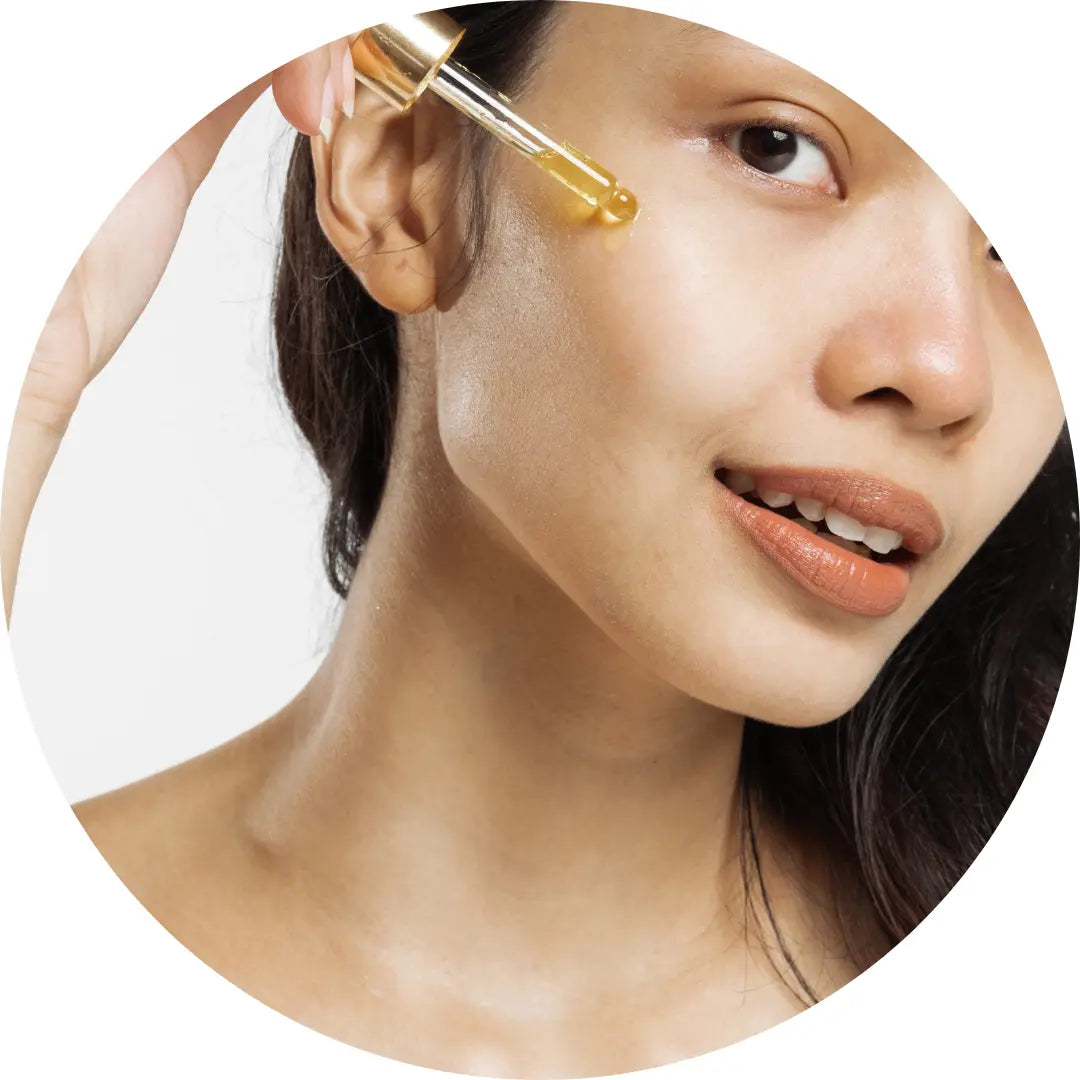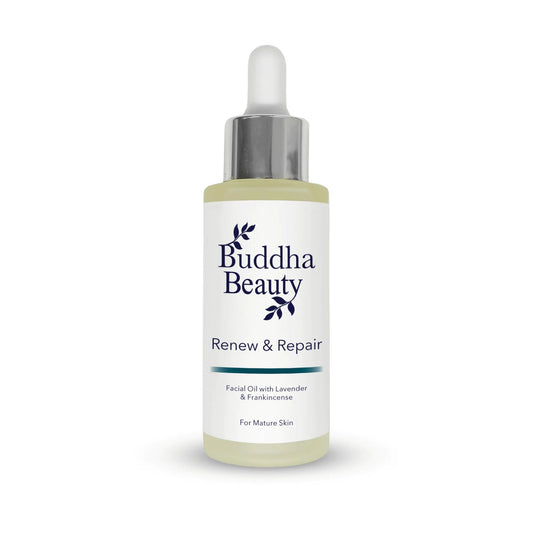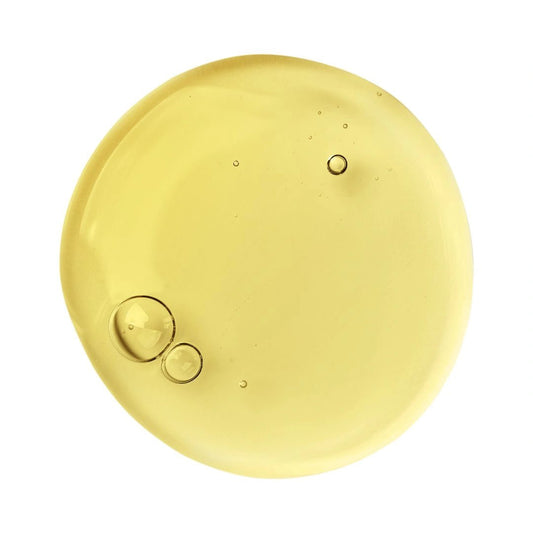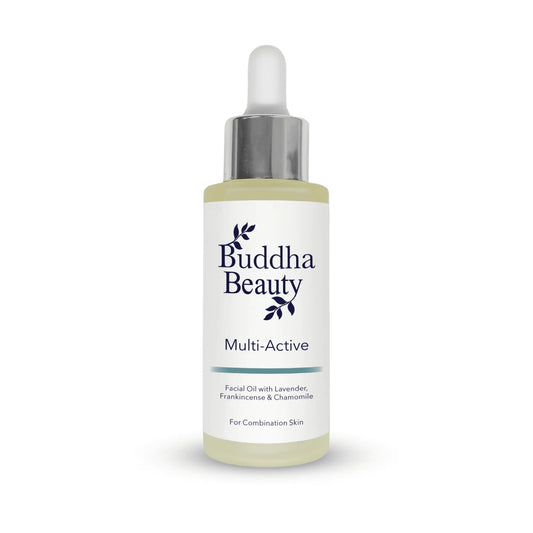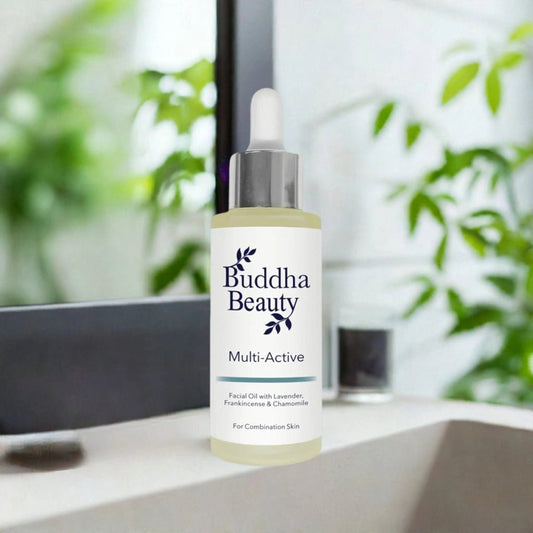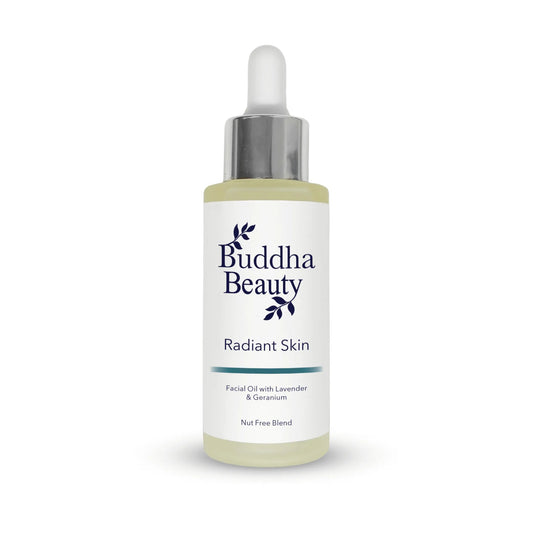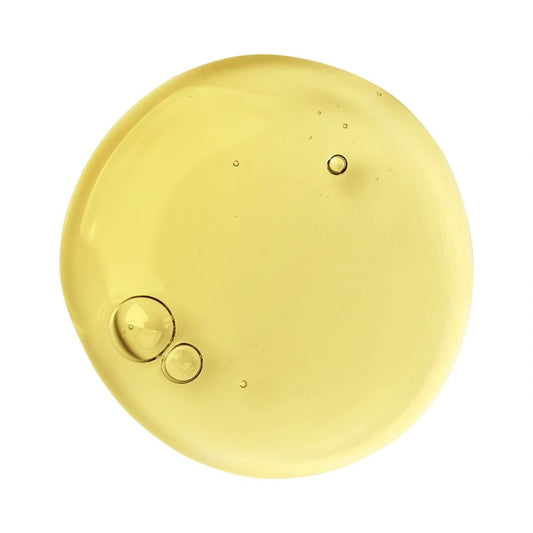Unlock the secrets of a radiant complexion with Buddha Beauty's Vegan Facial Oils, your go-to for intensive skin nourishment.
Our facial oils are a blend of natural, vegan ingredients that deeply hydrate, rejuvenate, and balance your skin.
Whether you have dry, oily, or combination skin, our range of face oils offers specialized formulations that adapt to your specific needs.
Rich in essential fatty acids and antioxidants, these oils for face care work to improve skin elasticity, combat signs of aging, and provide a protective barrier against environmental stressors.
The lightweight, non-greasy formula ensures quick absorption, making it a versatile part of your skincare routine—use it alone or mix it with your favourite moisturiser or facial serum.
Experience the transformative effects of adding a face oil to your regimen, and revel in a healthier, more glowing complexion.
What Is A Face Oil?
A face oil is a type of skincare product designed to provide nourishment, hydration, and protection to the skin. A skin oil is usually formulated with a blend of natural plant-based oils, which contain beneficial fatty acids, vitamins, and antioxidants and works great after a cleanse and a face mask. Here's what you need to know about face oils:
The best Facial oils are typically made from plant-based oils like argan oil, jojoba oil, rosehip oil, and others. A good face oil is rich in nutrients that can benefit the skin and are the best oil for face and can also be used as a face massage oil. They often contain:
- Fatty acids: These help maintain the skin's moisture barrier and prevent moisture loss.
- Vitamins: Vitamins A, C, E, and others are common in a face oil, providing antioxidant benefits and helping with skin repair.
- Antioxidants: These protect the skin from environmental damage and free radicals.
Importance of face oils in modern skincare routines.
Face oils have surged in popularity and have become a staple in modern skincare routines due to their multifaceted benefits and versatility and have been used as face massage oil for a long while before. Here’s a closer look at why face oils are gaining importance and when to use face oil:
1. Enhanced Moisturisation
The best facial oils are highly effective at locking in moisture. They form a protective barrier on the skin’s surface, preventing water loss and keeping the skin hydrated for longer periods. This is particularly beneficial in harsh weather conditions ,for individuals with dry skin and as a night oil for face.
2. Potent Nutrient Delivery
A skin oil for face care are concentrated sources of essential fatty acids, vitamins, and antioxidants, which are vital for maintaining skin health. They penetrate deeply into the skin, delivering a rich dose of nutrients. Ingredients like vitamin E and omega fatty acids can help to repair and regenerate skin cells, leading to improved skin texture and resilience.
3. Balancing Oil Production
Contrary to popular belief, a face oil can be beneficial for oily skin. Certain oils, such as jojoba oil, mimic the skin’s natural sebum and can signal the skin to adjust its oil production, reducing excess oiliness.
4. Soothing Sensitive Skin
Face oils like chamomile and calendula are known for their anti-inflammatory properties, making them excellent face oil for sensitive skin. The best facial oils can help reduce redness, calm acne flare-ups, and soothe other forms of skin irritation.
5. Anti-Aging Properties
Many face oils contain antioxidants which fight free radical damage, one of the culprits behind aging. The best facial oil for mature skin used regular can help diminish the appearance of fine lines and wrinkles while enhancing skin firmness and elasticity. A face oil for dry skin is great for maturing skin and also a good oil for face hydration.
6. Simplicity and Purity
With a growing preference for minimalistic skincare routines, a face oil offers a simple yet effective approach to skin health, often with minimal additives or chemicals. This purity makes them a preferred choice for those looking to reduce their exposure to synthetic ingredients.
7. Customisable Skincare
Face oils can be blended or used in combination to tailor a skincare routine that fits individual needs and concerns. Users can mix oils with varying properties to achieve desired outcomes, such as added radiance, increased hydration, or calming effects.
8. Primer for Makeup
Face oils have also become popular as a base for makeup. They provide a smooth, plumped surface that enhances the application of foundation and other products, allowing for a more seamless and glowing finish.
9. Environmentally Friendly Options
With an increasing trend towards eco-friendly and sustainable beauty products, face oils often meet these criteria. Top face oils typically require less packaging and are made with natural, biodegradable ingredients.
As the skincare industry continues to evolve, face oils remain a significant and expanding segment. Their ability to address a broad spectrum of skincare needs while promoting a holistic approach to skin health underscores their growing importance in daily beauty regimens.
Types of Face Oils
Face oils come in a variety of types, each derived from different plant sources and offering specific facial oil benefits to the skin. Here’s a breakdown of our face oils and what they can do for your skin:
Renew & Repair Facial Oil for Mature Skin
Unlock Timeless Beauty with Our Renew & Repair Organic Face Oil for Mature Skin. The best facial oil for ageing skin in the UK.
Introducing your passport to age-defying radiance: our Renew & Repair Organic Face Oil.It's Specifically designed as the best facial oil for mature skin, this luxurious oil offers more than just nourishment it's an oil for face hydration —it promises a journey back in time, restoring your skin's youthful vibrancy, just the best face oil for maturing skin and a great face oil at night to restore hydration.
Deep Hydration:
Provides intense moisture, perfect for replenishing dry, mature skin.
Acts as an oil for face hydration, ensuring your skin stays supple and plump.
Restores Youthful Vibrancy:
Revitalises dull, tired skin, bringing back a youthful glow.
Helps to smooth out fine lines and wrinkles, giving your skin a more youthful appearance.
Organic and Natural Ingredients:
Formulated with high-quality organic ingredients, free from harmful chemicals.
Safe and gentle for sensitive, mature skin types.
Nourishes and Protects:
Packed with essential vitamins and antioxidants that nourish and protect the skin.
Helps to fortify the skin’s natural barrier, shielding it from environmental damage.
Improves Skin Texture:
Enhances the skin’s texture, making it feel softer and smoother.
Promotes an even skin tone, reducing the appearance of age spots and pigmentation.
Night-time Renewal:
An ideal face oil at night to restore hydration and repair skin while you sleep.
Supports the skin’s natural regenerative process, ensuring you wake up with refreshed and revitalised skin.
Non-Greasy Formula:
Absorbs quickly without leaving a greasy residue, making it perfect for daily use.
Can be used under makeup for a dewy, fresh look.
Boosts Elasticity:
Improves skin’s elasticity, making it firmer and more resilient.
Helps to maintain the skin’s natural bounce and flexibility.
Enhances Radiance:
Promotes a radiant, healthy-looking complexion.
Helps to brighten the skin, giving it a more vibrant and youthful appearance.
Combination facial oil
Experience unparalleled skincare luxury & improve your skincare ritual tailored for the unique demands of combination skin with our Multi-Active Organic Facial Oil. This ground-breaking product goes beyond mere hydration; it’s a masterfully curated blend of natural oils designed to bring equilibrium to your skin’s diverse needs.
Balanced Hydration:
Provides targeted moisture to dry areas while controlling excess oil in oily zones.
Ensures that your skin remains balanced and well-hydrated throughout the day.
Equilibrium for Combination Skin:
Specifically formulated to address the diverse needs of combination skin.
Helps to harmonise the skin’s varying textures, promoting a more uniform complexion.
Natural and High-Quality Ingredients:
Crafted with a blend of natural oils, free from synthetic additives and harsh chemicals.
Safe and gentle, suitable for sensitive combination skin types.
Lightweight and Non-Greasy:
Absorbs quickly into the skin without leaving a greasy residue.
Perfect for daily use, under makeup, or as part of your nighttime skincare routine.
Anti-Inflammatory Properties:
Contains ingredients that help to soothe and calm irritated skin.
Reduces redness and inflammation, promoting a more even skin tone.
Regulates Oil Production:
Helps to balance sebum production, preventing both excessive oiliness and dryness.
Keeps your skin looking fresh and matte without over-drying.
Nourishes and Protects:
Enriched with vitamins and antioxidants that nourish and protect the skin.
Shields the skin from environmental stressors and free radicals.
Improves Skin Texture:
Smooths and refines skin texture, making it feel soft and silky.
Promotes a more even and refined complexion, reducing the appearance of pores.
Enhances Radiance:
Boosts the skin’s natural glow, giving it a healthy, radiant appearance.
Helps to brighten dull areas, bringing life and vibrancy to your complexion.
Radiant Skin Nut-Free Facial Oil
Unlock the Secret to Flawless, Radiant Skin Nut Free Organic Facial Oil with Our Nut-Free organic Face Oil
Introducing the ultimate in allergy-friendly luxury skincare: our Radiant Skin Nut-Free Facial Oil. Finally, a product that addresses the specific needs of those with nut allergies without compromising on performance or quality.
Expertly crafted with an exclusive blend of sunflower seed, grape seed, and jojoba oils, this exceptional facial oil delivers unparalleled hydration and nourishment. Say goodbye to excess sebum and uneven texture as our unique formula works to balance your skin, offering the perfect harmony between moisture and oil control.
Allergy-Friendly:
Specifically formulated without nut oils, making it safe for those with nut allergies.
Provides peace of mind for users with sensitivities, ensuring a safe skincare experience.
Unparalleled Hydration:
Delivers deep and lasting moisture with a blend of sunflower seed, grape seed, and jojoba oils.
Keeps your skin well-hydrated, soft, and supple throughout the day.
Balanced Moisture and Oil Control:
Expertly crafted to balance the skin's moisture levels and control excess sebum.
Helps to maintain a healthy, non-greasy glow, perfect for those with oily or combination skin.
Improves Skin Texture:
Smooths and refines the skin’s surface, reducing the appearance of uneven texture.
Promotes a silky, smooth complexion, making your skin look and feel more refined.
Nourishing and Protective:
Enriched with vitamins and antioxidants that nourish and protect the skin from environmental damage.
Supports the skin’s natural barrier, enhancing its resilience and vitality.
Lightweight and Fast-Absorbing:
Absorbs quickly into the skin without leaving a heavy or greasy residue.
Ideal for daily use, providing hydration without clogging pores.
Enhances Radiance:
Boosts your skin’s natural glow, giving it a healthy and radiant appearance.
Helps to brighten dull skin, enhancing overall luminosity.
Soothes and Calms:
Contains soothing properties that help to calm irritated or sensitive skin.
Reduces redness and inflammation, promoting a more even and calm complexion.
Versatile Use:
Suitable for all skin types, including sensitive, oily, and combination skin.
Can be used as part of your morning or evening skincare routine, offering flexibility and convenience.
Facial oil benefits
Facial oils are a beloved component in many skincare routines, cherished for their natural origin and potent benefits. Here’s an overview of the keyfacial oil benefits the best facial oils offer:
1. Intense Hydration
A hydrating face oil is excellent at locking in moisture. They form a barrier that helps to keep hydration within the skin, particularly beneficial in cold or dry climates. Top face Oils like argan, coconut, and almond are particularly known for their hydrating properties such great oil for face hydration and a great facial oil for dry skin.
2. Nourishing the Skin
Rich in vitamins, antioxidants, and essential fatty acids, facial oils provide a concentrated dose of nourishment to the skin. These nutrients help to repair, rejuvenate, and maintain healthy skin cells. For example, rosehip oil is high in vitamins A and C, which are crucial for collagen production and skin repair.
3. Balancing Oil Production
While it might seem counterintuitive, using the right kind of face oil can actually help regulate and balance natural oil production in the skin. Oils like jojoba closely mimic the skin's natural sebum, helping to balance oil levels without clogging pores.
4. Soothing Sensitive Skin
The best facial oil can have powerful anti-inflammatory properties, making them an ideal face oil for sensitive skin. Chamomile and calendula oils, for instance, are well-known for their soothing effects.
5. Enhancing Skin Elasticity
The antioxidant properties of facial oils can help fight free radicals, which contribute to skin aging. Regular use of certain oils, such as pomegranate or grapeseed oil, can improve skin elasticity and reduce the appearance of fine lines and wrinkles.
6. Protecting the Skin
An Organic face oil naturally contain antioxidants which protect the skin by limiting the production of free radicals, which can damage skin cells. This protection helps prevent signs of aging and can shield the skin from environmental stressors.
7. Healing and Repair
Some oils for face care have specific healing properties, making them beneficial for repairing skin damage such as scars, sunburn, or irritation. Tamanu oil, for example, is renowned for its ability to heal and regenerate skin tissue.
8. Promoting a Healthy Glow
Facial oils can give the skin a beautiful, natural glow. Their emollient properties smooth and luminize the skin, often resulting in a radiant and healthy-looking complexion.
9. Cleansing
Oils like castor and coconut oil can also be used for oil cleansing, a method that effectively dissolves makeup, dirt, and excess oil from the skin, purifying while maintaining skin's moisture.
10. Versatility and Ease of Use
Facial oils can be used alone, mixed with other skincare products, or even used as a base for makeup to enhance hydration and give a dewy finish, knowing when to use face oil is key.
Given these diverse benefits, facial oils can be a versatile and effective addition to nearly any skincare regimen, whether it's a hydrating face oil, improved skin texture, or a radiant glow. When choosing a facial oil, consider your specific skin type and needs to select the most beneficial oil.
Which oils are best for various skin types?
Choosing the right face oil can make a significant difference in your skincare routine. Different skin types require specific oils to address their unique needs. Here’s a guide to help you find the best face oils for various skin types, featuring some of our top products.
1. For Mature Skin:
As skin matures, it tends to lose moisture and elasticity, leading to fine lines and wrinkles. Oils rich in antioxidants and essential fatty acids are ideal for nourishing and revitalising mature skin. Our Renew & Repair Organic Facial Oil is specifically designed to address these concerns. This luxurious oil not only hydrates but also helps restore your skin's youthful vibrancy, making it an excellent choice for mature skin.
2. For Combination Skin:
Combination skin can be tricky to manage, as it has both oily and dry areas. The right face oil should balance these varying needs without clogging pores. Our Multi-Active Organic Facial Oil is perfect for this skin type. It is formulated to regulate oil production while providing necessary hydration to dry areas, leaving your skin balanced and radiant.
3. For Sensitive Skin:
Sensitive skin requires gentle, non-irritating oils that soothe and protect. Oils free from nuts and harsh additives are often the best choice. Our Radiant Skin Nut-Free Organic Facial Oil is an excellent option for sensitive skin. This oil is formulated to nourish and calm the skin without causing irritation, ensuring a radiant and healthy complexion.
4. For Oily Skin:
Contrary to popular belief, face oils can be beneficial for oily skin. The key is to choose lightweight, non-comedogenic oils that help regulate oil production without clogging pores. Oils like jojoba oil and grapeseed oil are excellent choices as they mimic the skin’s natural sebum and help balance oil levels.
5. For Dry Skin:
Dry skin benefits from rich, nourishing oils that provide deep hydration and lock in moisture. Oils such as argan oil, avocado oil, and rosehip oil are ideal for dry skin as they are packed with essential fatty acids and vitamins that nourish and repair the skin barrier.
6. For Acne-Prone Skin:
For acne-prone skin, it's crucial to use oils that are non-comedogenic and have anti-inflammatory properties. Tea tree oil and hemp seed oil are great options as they help reduce inflammation and prevent breakouts while keeping the skin hydrated.
7. For Normal Skin:
Normal skin types can use a variety of oils to maintain their skin’s health and balance. Oils like marula oil and squalane oil are lightweight, easily absorbed, and provide the right amount of hydration and nourishment.
Incorporating the right face oil into your skincare routine can provide targeted benefits, ensuring your skin looks and feels its best. Explore our range of organic facial oils to find the perfect match for your skin type.
How To Use & Apply Face Oils?
Applying face oils correctly and knowing when to use face oil can maximise their benefits for your skin. Here’s a detailed guide on how to properly use our organic face oil in your skincare routine:
1. Choose the Right Oil
Select a face oil that suits your skin type and addresses your specific skin concerns. For instance, jojoba oil is great for oily skin due to its similarity to natural sebum, while a face oil for dry skin might benefit more from richer oils like argan or coconut oil an oil for face hydration. Always try and pick the best rated oils for your skin type.
2. Cleanse Your Skin
Always start with a clean face. Use your regular cleanser or gentle face scrub to remove impurities and excess oils from the skin, ensuring that the face oil can penetrate effectively without any barriers.
3. Apply to Damp Skin
For the best results, apply face oil to damp skin. This can be after washing your face or following the application of a water-based toner or serum. The moisture on your skin will help the oil absorb better.
4. Measure the Right Amount
Typically, 2-3 drops of oil are enough for the entire face and neck. Using more can leave your skin feeling greasy and might lead to product waste, as a little goes a long way with high-quality oils.
5. Warm the Oil
Before application, warm the oil by rubbing the drops between your palms. This helps to release the active ingredients and ensures a smoother application.
6. Apply Gently
Using your fingertips, gently press or pat the oil into your skin. Avoid rubbing, as this can stretch the skin. Focus on areas that might need more hydration or treatment.
7. Use the Right Technique
Apply the oil with outward and upward strokes, gently massaging the face. This technique can aid in absorption and boost circulation, enhancing the skin's natural glow.
8. Layer Correctly
If you use multiple skincare products, apply the natural face oil after water-based products like serums but before heavier creams or moisturizers. This allows the oil to penetrate the skin deeply without being blocked by thicker products.
9. Adjust Usage According to Need
Depending on your skin’s daily needs, you may adjust the amount of oil or how often you apply it. In drier climates or seasons, you might need a bit more oil or an additional application in the afternoon.
10. Consider Night Application
Applying the best face oil for you at night can be particularly beneficial, as it supports the skin’s natural repair process during sleep. Nighttime is an excellent opportunity for the skin to benefit from the nourishing and regenerative properties of facial oils for example a hydrating face oil is great for nighttime use.
By following these steps, you can effectively integrate face oils into your skincare routine, ensuring that your skin receives the maximum benefits these potent products offer. Whether for added hydration, anti-aging effects, or a radiant complexion, face oils can be a transformative part of your daily skincare.
Best time to apply face oils to incorporate into your existing skincare routine.
Facial oils can be a valuable addition to your skincare routine, and choosing the right times to apply them can enhance their benefits. Here’s a look at the best times of day when use facial oils and why these moments are particularly effective:
1. Morning Application
- Prepares and Protects Skin: Applying facial oil in the morning after cleansing and before applying sunscreen can help fortify the skin's barrier, making it more resilient against environmental stressors like pollution and UV rays.
- Foundation for Makeup: Facial oils can serve as an excellent base for makeup. They can help to hydrate the skin and provide a smooth surface, reducing the appearance of pores and fine lines. A light oil like jojoba or is ideal for daytime use because they absorb quickly and don’t leave a greasy residue.
2. Evening Application
- Enhances Repair During Sleep: The skin undergoes natural repair processes at night, making this an optimal time to use richer, nourishing oils like rosehip. These oils can support the skin's regeneration and repair damage from the day’s exposure to pollutants and other irritants.
- Deep Moisturization: Applying oil in the evening allows for more intensive hydration, as it has several hours to absorb and won't be affected by makeup or other daytime products.
3. After Showering or Bathing
- Locks in Moisture: The best time to apply facial oil is when your skin is still damp after cleansing. The best facial Oil can lock in the moisture that’s on your skin and provide a protective layer. Warm skin also absorbs oils more effectively, maximizing their benefits.
4. As Needed Throughout the Day
- For Dry or Flaky Skin: If your skin tends to dry out during the day, especially in cold or dry climates, a midday touch-up with a small amount of facial oil can help. Just a drop or two can refresh your skin and soothe dry patches and finish with one of our lip balms for a natural flawless look.
Tips for Applying Facial Oils
- Use Sparingly: With the best rated face oil a little goes a long way with facial oils. Start with a few drops and add more as needed, depending on how your skin feels.
- Warm Between Hands: Before applying, warm the oil in your palms to enhance absorption and application.
- Press Gently Into Skin: Instead of rubbing the oil, press it into your skin with gentle tapping motions to encourage absorption without pulling the skin.
Integrating facial oils into your skincare routine at these times can help you leverage their full potential of facial oil benefits , whether for hydration, protection, or enhancing skin health. Each type of natural face oil offers distinct benefits, so selecting one that suits your skin’s needs and your lifestyle will provide the best results.
Key Ingredients In Face Oil & Their Advantages
Vegan facial oils are rich in plant-based ingredients that offer a variety of skin benefits. Here are some key ingredients commonly found in our vegan facial oils and their advantages:
Sweet Almond oil
Sweet almond oil is a versatile and widely used oil in both skincare and haircare due to its numerous benefits. Here are some of the main advantages of using sweet almond oil:
1. Moisturising Properties
Sweet almond oil is highly emollient, which means it helps to balance the absorption of moisture and water loss. It is particularly beneficial for dry, flaky, and irritated skin, providing deep hydration and softening the skin due to its rich content of fatty acids.
2. Rich in Vitamins
This oil is packed with vitamins, including Vitamin E, Vitamin A, and essential fatty acids. Vitamin E is an antioxidant that helps to protect the skin from UV radiation damage and improves skin barrier function. Vitamin A can stimulate the production of new skin cells and reduce fine lines.
3. Improves Complexion and Skin Tone
Sweet almond oil is known for improving the complexion and skin tone. It helps to even out the skin tone and can reduce the appearance of scars and dark marks, contributing to a clearer and brighter complexion.
4. Anti-Inflammatory Properties
It has anti-inflammatory properties, making it beneficial for conditions like eczema, psoriasis, or other forms of dermatitis. It can soothe irritated skin and reduce redness and swelling.
5. Reduces Puffiness and Under-Eye Circles
Sweet almond oil can also reduce puffiness and the appearance of under-eye circles, thanks to its anti-inflammatory properties. It's a gentle oil that can be safely used around the sensitive eye area.
6. Improves Hair Health
When used on hair, sweet almond oil can strengthen and repair hair damage due to its rich nutrient profile. It helps to smooth hair cuticles, adding shine and reducing split ends.
7. Non-Comedogenic
Despite being an oil, it is non-comedogenic, which means it won’t clog pores. This makes it suitable for all skin types, including those prone to acne.
Lavender oil
Lavender oil is cherished for its multitude of therapeutic and aesthetic benefits, making it a favorite in aromatherapy, skincare, and one of the best facial oil in wellness practices. Here’s a detailed look at some of its key benefits:
1. Calming and Relaxation
Lavender oil is widely known for its calming properties. The scent of lavender is believed to help reduce stress and anxiety, promote relaxation, and improve sleep quality. It’s commonly used in diffusers, pillow sprays, and personal care products to help soothe the mind and promote a peaceful state.
2. Anti-inflammatory and Healing Properties
Lavender oil has anti-inflammatory qualities that can help reduce redness, swelling, and inflammation. It can be applied to bug bites, minor burns, or other skin irritations to soothe discomfort and speed up the healing process.
3. Skin Care Benefits
Due to its antimicrobial and antioxidant characteristics, lavender oil is a popular choice in skincare. It can help combat bacterial infections and might reduce the occurrence of acne breakouts. Additionally, it’s used in products aimed at reducing signs of aging, as its antioxidants can help protect the skin from damaging free radicals.
4. Pain Relief
Lavender oil is also used as a natural remedy for pain relief. It may be effective in alleviating the pain associated with conditions like headaches, sprains, and menstrual cramps when massaged into the skin.
5. Hair Care
In hair care, lavender oil is believed to promote hair growth and reduce hair loss. It can be mixed with carrier oils and applied to the scalp to improve blood circulation, which is vital for nourishing hair follicles and improving hair health.
6. Improves Sleep
Applying lavender oil topically, or inhaling its scent before bed, can improve sleep quality. Its relaxing effect helps to calm the mind and body, making it easier to fall asleep and enjoy a more restful night.
Hazelnut oil
Hazelnut oil is a nourishing addition to facial care routines, offering a range of benefits due to its unique properties. Here are some key benefits of using hazelnut oil in skincare:
1. Moisturising Properties
Hazelnut oil is highly moisturizing and is known for its ability to penetrate deeply into the skin without leaving a greasy residue. It helps to hydrate and soften the skin, making it a suitable moisturizer even for those with oily skin, great in a hydrating face oil.
2. Rich in Antioxidants
This oil is loaded with antioxidants, such as vitamin E, which protect the skin from environmental stressors like pollution and UV radiation. Antioxidants also help in reducing signs of aging by fighting free radical damage.
3. Natural Astringent
Hazelnut oil has natural astringent qualities, which make it effective in tightening pores and regulating oil production. This can be particularly beneficial for those with oily or acne-prone skin as it helps to maintain a clearer and balanced complexion.
4. Enhances Skin Elasticity
The high levels of vitamin E and fatty acids in hazelnut oil can improve skin elasticity, making the skin appear firmer and more youthful. Regular use may help reduce the appearance of fine lines and wrinkles.
5. Gentle on Sensitive Skin
Due to its mild and soothing nature, hazelnut oil is often suitable for people with sensitive skin. It is less likely to irritate and can be used as a gentle moisturizer or carrier oil.
6. Collagen Production
The vitamins and fatty acids in hazelnut oil not only nourish the skin but also support collagen production. This is crucial for maintaining the skin's structure and preventing sagging.
7. Sun Protection
While hazelnut oil should not replace sunscreen, it does provide some degree of natural protection against sun damage due to its antioxidant content. However, it's important to continue using SPF protection daily for effective defense against harmful UV rays.
Jojoba seed oil
Jojoba oil is a favorite in skincare and one of the best facial oil for several reasons, primarily due to its unique chemical structure and benefits for the skin. Here are some of the main advantages of using jojoba oil on the face:
1. Moisturising Properties
Jojoba oil is similar in composition to the sebum naturally produced by our skin, which makes it highly effective as a moisturizer. It creates a protective barrier on the skin, which helps to retain moisture and keep the skin hydrated.
2. Non-Comedogenic
Unlike some other oils, jojoba oil is non-comedogenic, meaning it won't clog pores. This makes it a great option for all skin types, including those prone to acne.
3. Antioxidant Protection
Jojoba oil contains natural forms of vitamin E, an antioxidant that can help protect the skin from environmental stressors like pollution and UV rays.
4. Controls Oil Production
Because jojoba oil can mimic sebum, it can also help regulate oil production by sending a signal to your sweat follicles that your skin doesn't need additional sebum for hydration. This can be particularly beneficial for those with oily skin.
5. Soothes Dry Skin
Its anti-inflammatory properties help to reduce redness caused by drying, ease the effects of eczema and rosacea, and keep skin calm and comfortable.
6. Promotes Skin Health
The antioxidants and vitamins in jojoba oil help promote skin repair and damage control. Its iodine content fights harmful bacteria growth that can lead to breakouts.
7. Enhances Skin Barrier
The essential fatty acids in jojoba oil help to repair the skin barrier, improving skin's resilience.
8. Gentle and Hypoallergenic
Jojoba oil is also hypoallergenic, meaning it's generally safe for all skin types and is less likely to cause allergic reactions.
Safety & Precautions While Using Face Oils
Patch testing is a crucial step in safely incorporating new face oils or any skincare products into your routine, especially if you have sensitive skin or allergies. Here’s a step-by-step guide on how to perform a patch test:
Step 1: Choose the Right Area
The best places to perform a patch test are:
- Inside of your forearm: This area mimics the sensitivity of facial skin.
- Behind your ear: A discreet spot if you're concerned about visibility.
Step 2: Prepare the Area
Clean the area where you’ll apply the oil with mild soap and water to ensure it's free from dirt and oils. Pat it dry with a clean towel you can apply one of our facial toners after.
Step 3: Apply the Product
Place a small amount of the face oil on the area. You only need a drop or two. Cover it with a bandage to prevent the oil from rubbing off.
Step 4: Wait
Leave the oil on your skin for 24 to 48 hours. During this time, avoid washing the area to ensure that the product has enough time to potentially provoke a reaction.
Step 5: Observe the Reaction
After the waiting period, remove the bandage and check for any reactions. Signs of a negative reaction include:
- Redness
- Swelling
- Itching
- Burning sensation
- Blisters or rash
Step 6: Evaluate the Results
- No reaction: If there’s no sign of irritation or allergic reaction, it’s generally safe to proceed with using the product as part of your regular skincare routine.
- Mild reaction: If you notice minor irritation, you may want to be cautious and either test the product again in a different spot or consult with a dermatologist before further use.
- Severe reaction: If there’s a significant adverse reaction, wash the area immediately with soap and water, discontinue use of the product, and consult a healthcare provider if necessary.
Tips for Successful Patch Testing
- Document reactions: Taking pictures of the test area before and after the test can help you notice subtle changes.
- Test one product at a time: This helps you clearly identify which product may be causing a reaction.
- Keep the test area undisturbed: Try to avoid activities that lead to excessive sweating or washing of the test area during the testing period.
Patch testing helps minimize the risk of adverse reactions and is a good practice to implement regularly as part of introducing new skincare products to your routine.
Potential side affects and how to avoid them
Facial oils are generally safe for most skin types, but like any skincare product, they can cause side effects, particularly if not used correctly. Here are some potential side effects of facial oils and tips on how to avoid them:
1. Breakouts and Acne
Some facial oils can be comedogenic, meaning they might clog pores and lead to breakouts, especially in those with oily or acne-prone skin.
Prevention Tip: Choose non-comedogenic oils like argan oil, squalane, or hemp seed oil that are less likely to clog pores. Always perform a patch test before using a new oil.
2. Allergic Reactions
Ingredients in facial oils can cause allergic reactions, such as rashes, itching, or redness, especially in individuals with sensitive skin.
Prevention Tip: Always patch test a new oil on a small skin area before applying it to your face. Look for oils that are pure and without added fragrances or essential oils, as these can often trigger allergies.
3. Skin Irritation
Some oils, especially essential oils, can be irritating to the skin if used undiluted or in high concentrations.
Prevention Tip: Dilute essential oils with a carrier oil before application to reduce potency and the risk of irritation. Start with a low concentration and gradually increase as tolerated by your skin.
4. Over-Moisturising
Using too much oil or too frequently can lead to an over-hydrated skin condition, making the skin look greasy and potentially disrupting the natural balance of oils.
Prevention Tip: Apply only a few drops of face oil, and use it only once or twice a day, as needed. Adjust based on how your skin reacts and feels.
5. Photosensitivity
Certain oils, particularly citrus-based ones, can increase your skin's sensitivity to sunlight, leading to a higher risk of sunburn.
Prevention Tip: Avoid using citrus-based oils in the morning or when you expect sun exposure. If you do use these oils during the day, apply a broad-spectrum sunscreen over them.
By selecting the right type of oil for your skin type, using it in moderation, and being mindful of its ingredients, you can minimize the risk of side effects and make the most out of your facial oil's benefits. Always read labels carefully and consider consulting with a dermatologist if you have concerns about how a product may interact with your skin.
Choosing the Right Face Oil
Choosing the right face oil based on your skin concerns and desired outcomes involves understanding the properties of various oils and how they align with your skin's needs. Here are some tips to help you select the most suitable face oil:
1. Identify Your Skin Type
Knowing your skin type is crucial in selecting an appropriate face oil. Each skin type benefits from different types of oils:
- Oily Skin: Look for lightweight oils that won't clog pores, such as grapeseed or jojoba
- Dry Skin: Richer oils that provide more moisture are beneficial, like Argan, or almond oil.
- Sensitive Skin: Choose oils with anti-inflammatory properties to soothe the skin, such as calendula or chamomile.
- Combination Skin: A balancing oil like jojoba, which can regulate oil production, is ideal.
- Mature Skin: Oils rich in antioxidants and fatty acids, such as rosehip or pomegranate oil, can help combat signs of aging and are the best facial oil for mature skin.
2. Consider Your Skin Concerns
Select oils that specifically target your skin concerns:
- Acne-Prone Skin: Oils with antibacterial properties, like tea tree or neem, can help reduce breakouts.
- Hyperpigmentation: Look for oils with brightening properties, such as rosehip oil, which is high in vitamin C.
- Redness or Rosacea: Anti-inflammatory oils like chamomile can soothe skin and reduce redness.
- Dehydration: Oils like squalane and hyaluronic acid can help lock in moisture and hydrate the skin.
3. Check for Allergens
If you have sensitive skin or allergies, carefully read the ingredient lists to avoid potential irritants. Fragrance-free and pure oils without additives are generally safer options.
4. Quality of the Oil
Opt for high-quality, cold-pressed, unrefined oils whenever possible. These oils are minimally processed, retaining more of their natural nutrients and beneficial properties.
5. Packaging
Choose oils packaged in glass bottles. These help protect the oil from light, which can degrade some of its beneficial properties.
6. Patch Test
Always perform a patch test before fully incorporating a new oil into your skincare routine. This helps ensure you don’t have an adverse reaction to the oil.
7. Consultation
If unsure, consult with a dermatologist or skincare professional who can provide personalized advice based on your skin’s specific needs.
Maintenance and Care of facial oils
Storing face oils properly is crucial to maintain their effectiveness and extend their shelf life. Here are some guidelines on how to best store your face oils:
1. Keep Away from Direct Sunlight
Exposure to sunlight can degrade the oils, causing them to spoil faster due to the heat and light. Store your face oils in a cool, dark place away from windows.
2. Use Glass Bottles
Many high-quality face oils are packaged in glass bottles. These help block out light, which can oxidize and deteriorate the oil. If your oil doesn’t come in a glass bottle, consider transferring it to one.
3. Maintain a Cool Temperature
Heat can alter the chemical structure of face oils, reducing their effectiveness. Avoid storing oils in hot environments like near radiators, in the bathroom (where shower steam can heat them up), or near cooking areas. A cool, dry cupboard is ideal.
4. Tighten Caps Securely
Ensure the cap is always tightly closed after use. This prevents air from getting into the bottle, which can also cause the oil to oxidize and spoil.
5. Refrigeration for Some Oils
While not necessary for all face oils, some, especially those that are 100% pure and organic, might benefit from refrigeration. This is particularly true for oils that are prone to rapid oxidation, like rosehip oil. Check the manufacturer’s recommendations to see if refrigeration is advised.
6. Avoid Contamination
Always use clean hands or a dropper when applying face oil, and avoid letting the dropper touch your skin. This prevents bacteria from contaminating the oil.
Shelf life of our facial oils
All our facial oils have a shelf life of 12 months from opening.
Keep an eye on your oils for any changes in color, smell, or texture. These changes could indicate that the oil has gone bad. If you notice any rancid smells or significant color changes, it’s best to discard the oil.
Common Myths & Misconception About Face Oils
When it comes to using face oils, there are several common misconceptions and questions about their effects on skin, particularly regarding oiliness and comedogenicity. Here are some key points to clarify these misconceptions:
Misconception 1: All Face Oils Cause Breakouts
Reality: Not all face oils will cause breakouts. The effect of an oil on your skin depends on its composition and your skin type. Non-comedogenic oils like argan and hemp seed oil are less likely to clog pores or cause acne.
Misconception 2: Oils are Only for Dry Skin
Reality: While oils are excellent for hydrating dry skin, certain oils can benefit oily and combination skin types as well. For instance, jojoba oil mimics the skin’s natural sebum and can help regulate oil production, making it suitable for oily skin.
Misconception 3: Face Oils are Too Heavy and Greasy
Reality: The feel of an oil depends on its type and quality. Lighter oils like rosehip and grapeseed absorb quickly and don’t leave a greasy residue, making them suitable even for use under makeup.
Misconception 4: Face Oils Can Replace Moisturisers
Reality: Oils can hydrate and seal in moisture but they don't always replace the hydrating benefits of water-based moisturizers. For optimal hydration, especially for very dry skin, layering oil on top of a moisturizer can be more effective.
Now lets answer the most common questions asked alongwith the above misconceptions
How Do I Choose a Non-Comedogenic Oil?
Look for oils that are labeled non-comedogenic. Research or consult skincare resources to find oils with a lower likelihood of clogging pores. Common non-comedogenic oils include sunflower seed oil, safflower oil, and others mentioned earlier.
Can Face Oils Worsen Acne?
While oils like coconut oil may exacerbate acne for some due to their heavier and more occlusive nature, many oils have anti-inflammatory and antibacterial properties that can actually help improve acne. Tea tree oil, for instance, is known for its ability to combat acne-causing bacteria.
How Can I Test if an Oil is Comedogenic for Me?
Conduct a patch test by applying the oil to a small area of your skin, typically the inside of your forearm or along the jawline, and observe for any adverse reactions over a few days.
Understanding these aspects of face oils can help you make more informed decisions about incorporating them into your skincare routine. Always consider your skin type and specific skin needs when choosing an oil, and consult dermatological advice if you have concerns about how your skin might react.
Solutions for ineffective results or reactions to facial oils
If you experience reactions or find that a facial oil is ineffective, here are some strategies to address these issues:
1. Stop Using the Product
If you suspect a reaction, the first step is to discontinue use of the facial oil immediately. Continuing to use a product that is causing irritation can lead to more severe skin issues.
2. Identify the Symptom
- Mild irritation might include slight redness or a feeling of discomfort.
- Allergic reactions can appear as rash, hives, itching, or severe redness.
- Breakouts from comedogenic oils might include new acne spots, especially in areas where you applied the oil.
3. Treat the Symptoms
- For mild irritation, applying a cool compress can soothe the skin. Over-the-counter hydrocortisone cream can also help to reduce redness and inflammation.
- For allergic reactions, over-the-counter antihistamines can reduce itching and swelling. Consult a healthcare provider if symptoms persist or worsen.
- For breakouts, using a gentle cleanser and avoiding heavy skin creams can help clear up the skin. Products containing salicylic acid or benzoyl peroxide can help treat acne.
4. Patch Test Future Products
Before using a new facial oil, perform a patch test by applying a small amount to your inner forearm or behind the ear for a few days to monitor for any adverse reactions.
5. Review and Research Ingredients
Look back at the product's ingredient list to identify potential irritants. Cross-reference these ingredients with other products that have caused reactions in the past. Avoiding ingredients that consistently cause issues is key.
6. Consult a Dermatologist
If reactions are severe or if you're unable to pinpoint the cause, consult a dermatologist. They can provide professional advice, conduct allergy testing, and recommend products that are suitable for your skin type and concerns.
7. Hydration and Barrier Repair
If your skin barrier is compromised due to the reaction, focus on repairing it. Use products designed to strengthen the skin barrier, such as those containing ceramides, cholesterol, and fatty acids.
8. Alternative Products
Consider trying different types of facial oils or formulations. If pure oils cause issues, look for serums or moisturizers that contain oils in lower concentrations, which might be better tolerated.
How to blend face oils with other skincare products for customised skincare solutions?
Blending facial oils with other skincare products is a great way to customise your skincare routine to meet your specific skin needs. Here's a guide on how to effectively mix facial oils with other products:
1. Determine Your Skin Needs
Before mixing, identify what your skin needs. Do you need more hydration, acne control, anti-aging properties, or soothing ingredients? Understanding this will guide you in choosing the right products to mix with your facial oil.
2. Choose Compatible Products
Ensure that the products you choose to blend are compatible in terms of their base (water-based or oil-based). Generally, facial oils blend well with other oil-based products and can also be mixed into our creams, face cleansers or lotions as long as they are not highly water-based.
3. Mixing with Serums and Moisturisers
- Serums: Add a few drops of face oil to a dollop of your serum in your palm before applying. This can enhance the serum’s moisturizing properties and add additional benefits, like antioxidants or anti-inflammatory effects.
- Moisturisers: Blend a few drops of oil with your Frankincense night cream or neroli or Geranium day cream to increase the product’s nourishment. This is especially beneficial in drier climates or seasons.
4. Adding to Foundations
For a dewy, glowing complexion, mix one or two drops of facial oil with your liquid foundation. This not only helps in achieving a smoother application but also adds a hydrating effect to your makeup, making it less likely to cake or settle into fine lines.
5. Consider Texture and Absorption
When blending oils with other skincare products, consider the texture and absorption rate. Lighter oils like rosehip are generally more versatile and can be easily mixed with various products without altering their feel too much.
6. Adjust Quantities
Start with a small amount of oil, especially if you are new to mixing oils with other products. You can always add more if needed, but it’s important to see how your skin reacts to the new mixture.
7. Patch Test New Mixtures
Whenever you create a new blend, do a patch test to ensure your skin reacts well to the combination before applying it to your entire face.
8. Storage
If you mix a larger batch of a product with an oil, make sure to store it properly. Keep it in a cool, dark place to prevent the oil from going rancid or the active ingredients in the other products from degrading.
9. Observe and Adjust
Pay attention to how your skin responds after using the blend for a couple of weeks. Adjust the amount of oil or the other products as needed based on whether your skin is becoming too oily, remains dry, or feels perfectly balanced.
By customising your skincare products through careful blending, you can effectively address multiple skin concerns at once and enhance the efficacy of your skincare routine. Just remember to consider the compatibility of the ingredients and to monitor your skin’s response.
Role Of Face Oils In Anti-Aging
Facial oils can play a significant role in anti-aging skincare routines due to their nourishing properties and ability to deliver potent antioxidants and vitamins directly to the skin. Here’s how facial oils contribute to anti-aging efforts:
1. Moisturisation:
Facial oils are excellent at locking in moisture, which is crucial for maintaining the skin’s elasticity and plumpness. Hydrated skin can help reduce the appearance of fine lines and wrinkles, which are more pronounced on dry skin.
2. Rich in Antioxidants:
Many facial oils are high in antioxidants, which protect the skin from environmental stressors such as pollution and UV radiation. Antioxidants like vitamins A, C, and E can help prevent premature aging by neutralizing free radicals that cause oxidative stress to skin cells.
3. Promotes Skin Repair and Cell Regeneration:
Oils like rosehip and frankincense are known for their regenerative properties. They can help promote skin cell renewal and improve skin texture by reducing scars, hyperpigmentation, and age spots.
4. Enhances Skin Elasticity:
Facial oils can boost collagen production and support the skin’s natural repair mechanisms. Oils rich in essential fatty acids like omega-3 and omega-6 can help strengthen the skin's lipid barrier, improve moisture retention, and maintain its elasticity.
5. Provides a Barrier:
The best face oil will naturally create a barrier on the surface of the skin, which can help to protect it from the elements. This barrier retains more moisture and keeps the skin hydrated for longer periods, helping to maintain its youthful appearance.
6. Smoothens Skin Texture:
Regular application of facial oils can lead to a smoother skin texture, as these oils can fill in tiny cracks and gaps in the skin surface, giving it a softer, more even appearance.
Incorporation into Routine
To incorporate facial oils into an anti-aging routine, apply them after water-based products and before heavy creams. You can also mix them with your night cream for enhanced moisturization or use them under sunscreen during the day to provide extra protection and nourishment.
Pro Tip - Our beautifully crafted Gua Sha beauty tools made from natural stones, crystals and metals paired with our organic multi active facial oil can do wonders for your skin helping improving circulation, lymphatic drainage & tension relief.
Face Oils for Men
Men can greatly benefit from incorporating facial oils into their skincare routine, just like women. Here are some tailored advice and steps for men interested in using facial oils:
1. Identify Your Skin Type
First, determine your skin type (oily, dry, combination, sensitive) as this will influence the type of oil that will work best for you. For example:
- Oily Skin: Opt for lightweight, non-comedogenic oils like jojoba or grapeseed oil.
- Dry Skin: Look for more nourishing oils such as argan oil.
- Sensitive Skin: Choose soothing oils like chamomile.
2. Start with a Clean Base
Always apply facial oil to clean skin. Use a gentle cleanser to remove dirt, oil, and impurities before applying any oil. This helps the oil absorb better and prevent clogging of pores.
3. Application Technique
A little goes a long way with facial oils. Place 2-3 drops into the palm of your hand, rub your palms together to warm the oil, and gently press it onto your face and neck. Avoid vigorous rubbing which can irritate the skin.
4. Incorporate into Shaving Routine
Facial oils can be particularly beneficial as a pre-shave or post-shave treatment. Pre-shave, they can help to soften the beard and prepare the skin, reducing the risk of irritation and razor burn. Post-shave, they can soothe and moisturize the skin.
5. Combine with Other Skincare Products
If you use a moisturizer or sunscreen, you can apply the facial oil first and let it absorb for a few minutes before applying other products. Alternatively, mix a few drops of oil with your moisturizer to enhance its hydrating properties.
6. Use Sparingly
Especially for men who are new to facial oils, start by using the oil only in the evening to see how your skin reacts. Once you're comfortable, you can incorporate it into your morning routine, if desired.
7. Monitor Skin's Response
Pay attention to how your skin responds after introducing the oil. If you notice any negative reactions such as increased breakouts or irritation, consider trying a different oil or reducing the frequency of use.
8. Choose Quality Products
Opt for high-quality, pure oils without added fragrances or irritating ingredients, which are more likely to be gentle on the skin and more effective.
By following these steps, men can effectively incorporate facial oils into their skincare regimen, enjoying benefits like improved skin hydration, reduced irritation from shaving, and overall healthier-looking skin.

